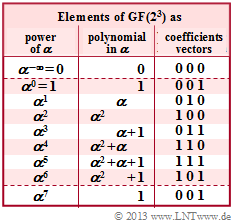Exercise 2.12: Decoding at RSC (7, 4, 4) to Base 8
We analyze the Peterson algorithm detailed in the section "Procedure for Bounded Distance Decoding". Assumed is the Reed–Solomon code with parameters $n = 7, \ k = 4$ and $d_{\rm min} = 4$, where all code symbols come from $\rm GF(2^3)$ and all arithmetic operations are consequently to be performed in $\rm GF(2^3)$ as well.
The parity-check matrix of this code is:
- $${ \boldsymbol{\rm H}} = \begin{pmatrix} 1 & \alpha^1 & \alpha^2 & \alpha^3 & \alpha^4 & \alpha^5 & \alpha^6\\ 1 & \alpha^2 & \alpha^4 & \alpha^6 & \alpha^1 & \alpha^{3} & \alpha^{5}\\ 1 & \alpha^3 & \alpha^6 & \alpha^2 & \alpha^{5} & \alpha^{1} & \alpha^{4} \end{pmatrix} \hspace{0.05cm}.$$
- In "Step $\rm (A)$" of the decoding algorithm considered here, the syndrome $\underline{s} = \underline{y} \cdot \mathbf{H}^{\rm T}$ must be computed.
- For the received word $\underline{y} = (\alpha^1, \, 0, \, \alpha^3, \, 0, \, 1, \, \alpha, \, 0)$, the syndrome results in $\underline{s} = (\alpha^4, \, \alpha^5, \, \alpha^6)$, as in the Exercise 2.12Z yet to be shown.
- After that the "ELP coefficient vectors" be set up and evaluated according to the adjacent figure, where the assignment depends on whether one assumes $r = 1, \ r = 2$ or $r = 3$ symbol errors in the received word.
- If all equations ${\it \underline{\Lambda}}_l \cdot \underline{s}^{\rm T} = 0$ are satisfied for the assumed symbol error count $r$, then the received word $\underline{y}$ actually has exactly $r$ symbol errors.
Hints:
- The exercise refers to the chapter "Error correction according to Reed–Solomon coding".
- "ELP" stands for "Error Locator Polynomial".
- You can take the further steps from the theory part:
- Step $\rm (C)$: "Localization of error locations",
- Step $\rm (D)$: "Determination of the error values".
Questions
Solution
- The considered Reed–Solomon code $(7, \, 4, \, 4)_8$ can only correct $t = ⌊(d_{\rm min} - 1)/2⌋ = 1$ symbol errors because of $d_{\rm min} = 4$.
- So only the scheme with blue background is relevant, which is valid for the case that there is exactly one symbol error in the received words $(r = 1)$.
(2) According to the graph on the specification page, the vector ${\it \underline{\Lambda}}_l$ here has $L = n - k \ \underline{= 3}$ elements.
(3) There are only the two ELP coefficient vectors ${\it \underline{\Lambda}}_1 = (\lambda_0, \, 1, \, 0)$, ${\it \underline{\Lambda}}_2 = (0, \, \lambda_0, \, 1) \ \Rightarrow \ l_{\rm max} \ \underline{= 2}$.
(4) From ${\it \underline{\Lambda}}_1$ and ${\it \underline{\Lambda}}_2$ we get two scalar equations of determination ⇒ ${\it \underline{\Lambda}}_l \cdot \underline{s}^{\rm T} = 0$ for the parameter $\lambda_0$:
- $$\lambda_0 \cdot \alpha^4 + \alpha^5 \hspace{-0.15cm} \ = \ \hspace{-0.15cm} 0 \hspace{0.3cm} \Rightarrow \hspace{0.3cm} \lambda_0 \cdot \alpha^4 = -\alpha^5 = \alpha^5 \hspace{0.3cm} \Rightarrow \hspace{0.3cm} \lambda_0 = \alpha \hspace{0.05cm},$$
- $$\lambda_0 \cdot \alpha^5 + \alpha^6 \hspace{-0.15cm} \ = \ \hspace{-0.15cm} 0 \hspace{0.3cm} \Rightarrow \hspace{0.3cm} \lambda_0 = \alpha \hspace{0.05cm}.$$
The equation system is uniquely solvable ⇒ Answer YES.
(5) Using the result of subtask (4) ⇒ $\lambda_0 = \alpha$, we obtain for the error locator polynomial:
- $${\it \Lambda}(x)=x \cdot \big ({\it \lambda}_0 + x \big ) =x \cdot \big (\alpha + x )$$
- $$\Rightarrow \hspace{0.3cm} {\it \Lambda}(\alpha^0 )\hspace{-0.15cm} \ = \ \hspace{-0.15cm} 1 \cdot \big ( \alpha + 1 \big ) = \alpha + 1 \ne 0 \hspace{0.3cm} \Rightarrow \hspace{0.3cm}{\rm No\hspace{0.15cm} zeros}\hspace{0.05cm},$$
- $$\hspace{0.875cm} {\it \Lambda}(\alpha^1)\hspace{-0.15cm} \ = \ \hspace{-0.15cm}\alpha \cdot \big (\alpha + \alpha\big ) = 0 \hspace{0.3cm} \Rightarrow \hspace{0.3cm}{ \boldsymbol{\rm Zeros}}\hspace{0.05cm}.$$
- So the symbol at position 1 was falsified ⇒ Solution suggestion 2.
- Since the calculation in subtask (4) was done under the condition $r = 1$, all other symbols were transferred correctly:
- $$\underline {e} = (0, e_1, 0, 0, 0, 0, 0)\hspace{0.05cm}. $$
(6) From the condition $\underline{e} \cdot \mathbf{H}^{\rm T} = \underline{s}^{\rm T}$ follows
- $$(0, e_1, 0, 0, 0, 0, 0) \cdot \begin{pmatrix} 1 & 1 & 1 \\ \alpha^1 & \alpha^2 & \alpha^3 \\ \alpha^2 & \alpha^4 & \alpha^6 \\ \alpha^3 & \alpha^6 & \alpha^9 \\ \alpha^4 & \alpha^8 & \alpha^{12} \\ \alpha^5 & \alpha^{10} & \alpha^{15} \\ \alpha^6 & \alpha^{12} & \alpha^{18} \end{pmatrix} \hspace{0.15cm}\stackrel{!}{=} \hspace{0.15cm} \begin{pmatrix} \alpha^4\\ \alpha^5\\ \alpha^6 \end{pmatrix} $$
- $$\Rightarrow \hspace{0.3cm} e_1 \cdot \alpha = \alpha^4\hspace{0.05cm},\hspace{0.4cm} e_1 \cdot \alpha^2 = \alpha^5\hspace{0.05cm},\hspace{0.4cm} e_1 \cdot \alpha^3 = \alpha^6\hspace{0.05cm}. $$
- The solution always leads to the result $e_1 = \alpha^3$ ⇒ Answer 2.
- With the received word $\underline{y} = (\alpha^1, \, 0, \, \alpha^3, \, 0, \, 1, \, \alpha^1, \, 0)$, the decoding result is $\underline{z} = (\alpha^1, \, \alpha^3, \, \alpha^3, \, 0, \, 1, \, \alpha^1, \, 0)$.
(7) Analogous to the subtask (4), the system of equations is now:
- $$\lambda_0 \cdot \alpha^2 + \alpha^4 \hspace{-0.15cm} \ = \ \hspace{-0.15cm} 0 \hspace{0.3cm} \Rightarrow \hspace{0.3cm} \lambda_0 = \alpha^2 \hspace{0.05cm},$$
- $$\lambda_0 \cdot \alpha^4 + \alpha^5 \hspace{-0.15cm} \ = \ \hspace{-0.15cm} 0 \hspace{0.3cm} \Rightarrow \hspace{0.3cm} \lambda_0 = \alpha \hspace{0.05cm}.$$
- The two solutions contradict each other. At least two symbols have been falsified during transmission. The decoding fails ⇒ Answer NO.
- You would now have to start a new attempt according to the red scheme $(r = 2)$.

